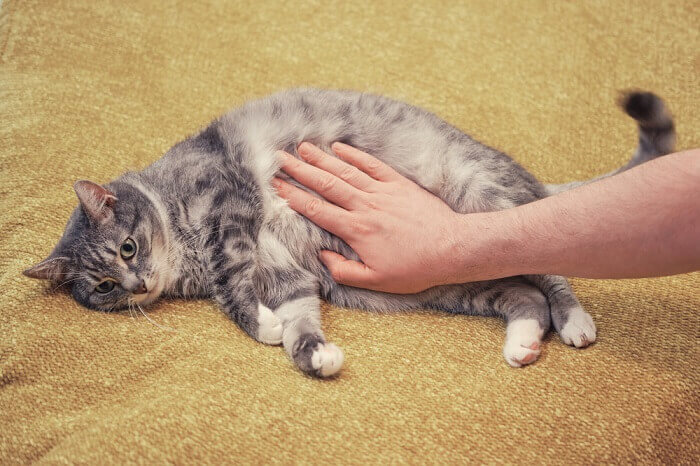
Our cats live closely with our families every day. Keeping them healthy and parasite free is extremely important. Intestinal parasites can occur in any age cat, and several types of intestinal worms infect our housecats.
Parasites such as roundworms, hookworms, whipworms and tapeworms cause weight loss, vomiting, diarrhea, and other gastrointestinal symptoms. Common tapeworms are a pesky example, and require specific treatment and prevention.
Tapeworms come in several varieties, with different species prevalent in certain environments. All tapeworms go through a life cycle that requires a host in order to mature and infect other animals. The tapeworms move from the egg form, or proglottid, through the larvae form, into an infectious form in the host. Eliminating the host can prevent reinfection for our pets.
Quick Overview: Tapeworms in Cats
 Other Names: Dipylidium caninum, Taenia species, Echinococcus species.
Other Names: Dipylidium caninum, Taenia species, Echinococcus species.
 Common Symptoms: Small white tapeworm segments appearing like small pieces of rice found in stool or around the anal area. Worms uncommonly vomited. rare weight loss.
Common Symptoms: Small white tapeworm segments appearing like small pieces of rice found in stool or around the anal area. Worms uncommonly vomited. rare weight loss.
 Diagnosis: Often diagnosed by direct visualization of tapeworm segments. Fecal flotation tests rarely detect tapeworm eggs. Newer PCR tests may be more sensitive.
Diagnosis: Often diagnosed by direct visualization of tapeworm segments. Fecal flotation tests rarely detect tapeworm eggs. Newer PCR tests may be more sensitive.
 Requires Ongoing Medication: No
Requires Ongoing Medication: No
 Vaccine Available: No
Vaccine Available: No
 Treatment Options: A specific deworming medication for tapeworms like praziquantel.
Treatment Options: A specific deworming medication for tapeworms like praziquantel.
 Home Remedies: Use of any natural or home remedies for intestinal parasites should always be rechecked with a stool sample and medications considered in the event of failure.
Home Remedies: Use of any natural or home remedies for intestinal parasites should always be rechecked with a stool sample and medications considered in the event of failure.
Types of Tapeworms

When your cat grooms and ingests an infected flea, the tapeworm cysticercoid infects your cat’s small intestine.
In cats, Dipylidium caninum and the Taenia species are the most common. Echinococcus and Mesocestoides are less prevalent in our domestic felines. The two common tapeworm species are transmitted very differently. Let’s talk about how they get them and how to prevent them in your feline friend.
Dipylidium caninum requires an infected flea for transmission. The larval form of the tapeworm enters and lives in the stomach of the adult flea, then matures into a cysticercoid.
When your cat grooms and ingests an infected flea, the tapeworm cysticercoid infects your cat’s small intestine. One of the most common things your veterinarian will check for are fleas. If your cat has fleas, you will need to treat both the flea issue as well as the tapeworm infection.
Just treating the tapeworm will lead to reinfection if the fleas are not completely eliminated and prevented. There are reliable and safe flea prevention options, so be sure to discuss with your veterinarian which flea control would be best.
Taenia species infections require that your cat eat part of an infected rodent, such as a mouse or rat. The tapeworm larvae mature into a cysticercoid form and live in the gastrointestinal tract of the rodent. When your feline hunter consumes the rodent, the tapeworm cysticercoid matures and infects the feline small intestine, setting up infection.
How Will You Know if Your Cat Is Infected?
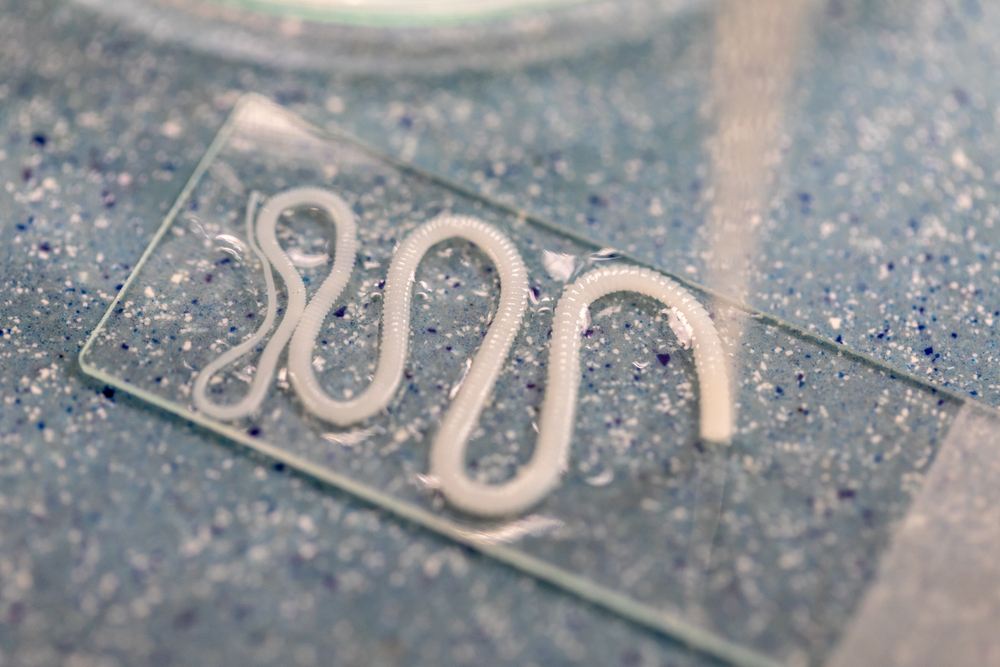
Most tapeworm infections in cats are asymptomatic, meaning that many cats don’t show any signs.
Tapeworm infections in pets are usually asymptomatic, meaning your cat may not show any signs. In severe cases, you might see vomiting or diarrhea, or in chronic cases, weight loss.These occur because the tapeworm’s mouth attaches to the wall of the cat’s small intestine and feeds there for weeks to months. If there are multiple adult tapeworms, an intestinal obstruction, or blockage, can occur and can be life-threatening.
The most common sign is the tapeworm segment.
These are small, white to cream-colored segments and look like grains of rice around the rectum or fur on the rear end. Your cat may scoot or have irritation around the anus.
The tapeworm segment is not the entire worm, though they may move around slightly. These are pieces of the tapeworm body and contain tapeworm egg packets. When these segments fall off the fur, they are then ready to infect again, waiting for flea larvae or rodent to come along and ingest the eggs to continue the cycle!
Diagnosis of tapeworms is confirmed by finding the eggs in the feces (a Fecal Ova and Parasite test) or by looking at one of the tapeworm segments under a microscope.
Your veterinarian can perform these tests, along with a full examination, to ensure your pet is otherwise healthy.
If you see the segments at home, you can use a piece of clear tape to preserve a segment. You can also bring in a fecal sample in a clean bag or plastic container. The specific species can be determined with a PCR (polymerase chain reaction) test at a diagnostic laboratory, though this is not generally necessary in order to treat.
Treatment and Prevention
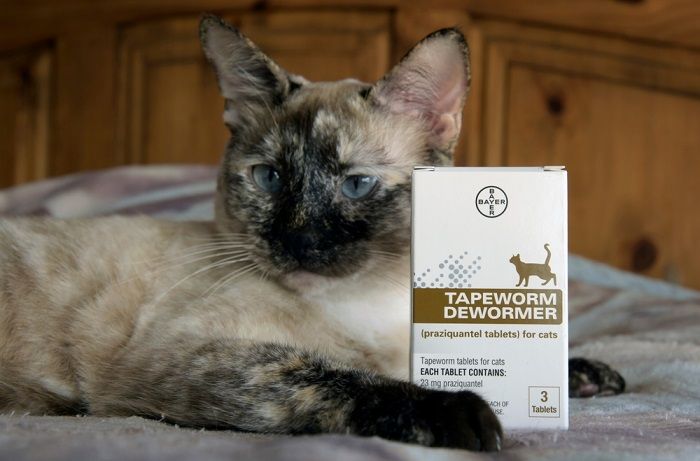
Cats with tapeworms need the right treatment. An effective dewormer will wipe out the parasites.
Tapeworms are a parasite and we need to use an appropriate and safe dewormer in order to eliminate them. There are two approved deworming medications available, praziquantel and epsiprantel.
Also Read: Best Cat Dewormers
Your veterinarian will be able to provide the best medication based on your pet’s weight and health. The dewormer may be oral, injectable, or even topical. Once administered, the deworming tapeworm medication will kill the parasite, and your cat’s immune and digestive systems will break down the worm internally.
Prevention of Tapeworms in Cats
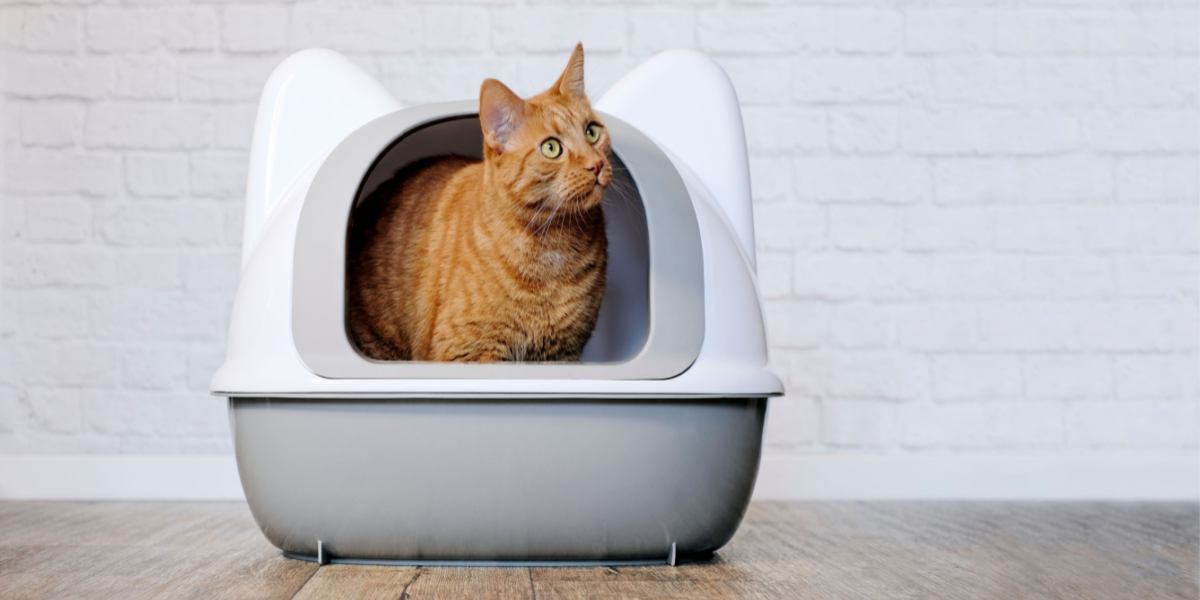
Prevention is key to avoid having to give medication for repeated infections. The Dipylidium species requires a flea for transmission, so flea prevention is essential.
It is important to discuss keeping all of your pets flea free, as it only takes two hitchhiking fleas from outside to cause a problem!
Taenia species from ingesting rodents can be trickier if your cat spends time outside, but limiting habitats for rodents can help.
Make sure to close off areas where pests like to hang out. These include under sheds, protected areas under porches, and unsecured waste receptacles. Provide opportunities to hunt at home, using puzzle feeders and toys that stimulate your cat’s predatory instincts.
Also Read: The 10 Best Cat Slow Feeders & Puzzle Feeders
While reports of natural remedies may sound tempting, no reliable or proven over the counter products exist that will eliminate the tapeworm.
Additionally, herbal and home remedies vary widely in quality and content, and may have toxic or damaging side effects. Be sure to ask your veterinarian before giving anything that is not prescribed.
Tapeworms in cats occur if your feline friend is a hunter or acquires a flea infestation. Thankfully, most tapeworm infections don’t cause significant health problems and may be asymptomatic.
If you see small grains of rice around the tail or in your cat’s feces, call your veterinarian for an appointment. Tapeworms are treatable with minima side effects and are preventable with good flea prevention and limited access to rodents.
Frequently Asked Questions
Are tapeworms in cats contagious to humans?
Some tapeworm species can spread to humans. Since it is difficult to tell the species without a PCR test, it is important to limit contact with the tapeworm segments. Washing bedding and surfaces along with good handwashing will prevent reinfection within an environment, though the eggs themselves are not infectious.
Are tapeworms in cats contagious to dogs?
Dogs and cats can both get common types of tapeworms. However, because the life cycle of a tapeworm requires an intermediate host such as the flea or rodent, direct transmission in not common.
Can you see tapeworms in cat poop?
Sometimes the worm segments will appear in cat feces. Most often, the tapeworm segments will look like white to cream grains of rice. The tapeworm itself does not usually come out in the feces, but can in heavy infestations and can be several inches long.
Can cats throw up tapeworms?
If there are multiple tapeworms or a heavy infection, a cat may throw up a tapeworm, though this is rare.
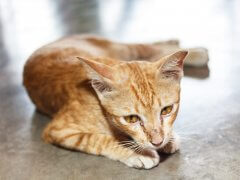



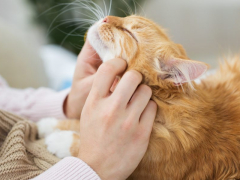



So if a segment of the tape worm comes out of cats rear end on a blanket does it die or will it be able to live in the blanket til the blanket is washed??
Outside of your cat’s body, these little segments will dry up and break open to release eggs. However, they can’t do much of anything unless someone ingests them so that they can hatch and develop inside of a host. Usually, that host is a flea. So, yes and no! I would recommend cleaning the blanket as soon as you can just to be on the safe side.
Thank you for the interesting comprehensive data.
A stray cat arrived on my veranda about 2 weeks ago. It is a skinny black and grey cat. It behaved as if it was starving and ate a lot of food. It now comes back 3 to 4 times a days, eats a full bowl of food and falls asleep on my veranda.
I was wonder, since the cat beats so much food if it might have a tape worm, or ” worms”! I checked it over carefully and saw no signs of worms. What do you think.
I already have 3 cats all were strays, otherwise I would adopt this stray.
Hi Ray,
Thanks for sharing, some cats may just have a healthy appetite, if you still have any doubts we recommend to contact your local veterinarian.
I saw a tapeworm around my cat’s anus after noticing he seemed different, sleeping all day, not playing at night like he usually does; I dewormed him the day I saw them, that being Friday evening, and now its Monday, and he still seems off. Should I be concerned about not playing, not having much energy, though he is still eating and drinking?
I would be a bit worried about that, yes; have you considered bringing your cat to a vet?
I adopted a 16 year old cat from a rescue center. He vomits constantly. He does best w/dry food but tries others. Usually the second time on new food UP it comes. I spent over $500. at a vet. She never addressed the main problem. She
had lots of blood work done. Everything was good but he has a heart murmur. She recomended I go to a cat cardiologist. He is very content but he does not purr. Sometimes I feel his purring but no sound. I keep finding white threadlike things on the floors. I have never seen anything near or around his rectum. I wanted to see pictures of worms but haven’t on numerous websites.
Hello Harriet, thank you for the question. Here’s a page with a nice graphic showing what several types of tapeworms look like; I’ve requested that some better photos be added to this article as well. Hope this helps.
Thank you doctor. My cat almost died from a bad flea infestation and my stupid vet never warned me about tapeworms. Now she keeps throwing up. I’m sending a fecal sample for analysis asap.
Can a cat vomit the segments out as well?
It does seem that in some cases, the tapeworms can make their way into the stomach, and the cat will vomit it up from there.
I had a cat vomiting daily and I got an orthotic cat bowl online. I never thought it would work and IT DOES! I now feed her Purina Gentle Formula dry food in a very small amount 3-4 times a day and Fancy Feast Turkey (Gravy Lovers) about a Tablespoon 3 times per day and she has stopped vomiting. So small portions and the tilted orthotic cat bowl did the trick.
Thanks for sharing!